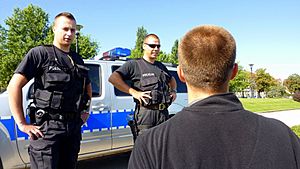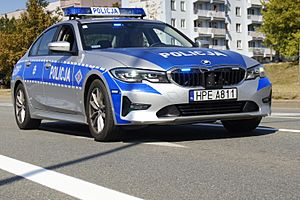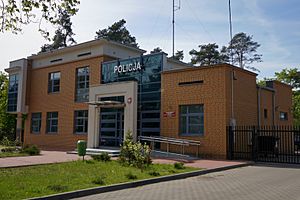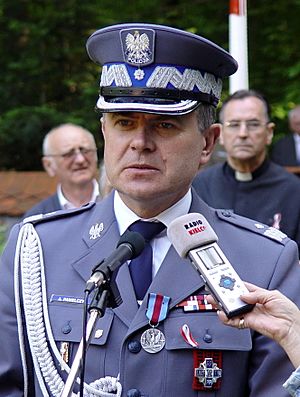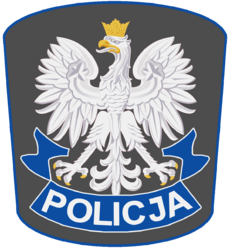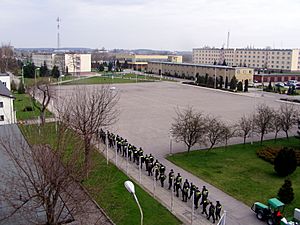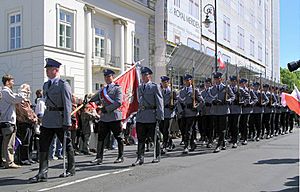Police of Poland facts for kids
Quick facts for kids Policja |
|
|---|---|

Wordmark of Policja
|
|
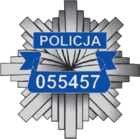
Badge of Policja
|
|

Polish Police vessels flag
|
|
| Agency overview | |
| Formed | 10 May 1990 |
| Preceding agency |
|
| Employees | 150 500 |
| Annual budget | 12 billion PLN (2022) |
| Jurisdictional structure | |
| National agency | PL |
| Operations jurisdiction | PL |
 |
|
| Jurisdiction of the Policja | |
| Constituting instruments |
|
| General nature | |
| Operational structure | |
| Headquarters | Warsaw |
| Minister responsible |
|
| Agency executive |
|
| Policja Regional HQs | 20 + 5 training centers |
| Website | |
| Policja (English) | |
Policja (pronounced poh-LEET-syah) is the official name for the national police force in Poland. This name was used for the Polish police from 1918 to 1939. It was brought back in 1990. Today, about 100,000 officers and 25,000 civilian staff work for the Policja. They have different groups, like the Criminal Service, Traffic Police, and Prevention Service.
Many cities and villages in Poland also have their own local police, called Straż Miejska or Straż Gminna. These local guards help keep public order and road safety. However, they mostly deal with smaller issues. For serious crimes, they work with the main state police.
Contents
What Does "Policja" Mean?
The word Policja simply means Police in English.
An individual police officer is usually called a policjant. If it's a female officer, she might be called policjantka. These are common terms, not official ranks. A police station is known as Komenda Policji or Komisariat Policji. When talking to an officer, people often use polite terms like Pan (mister) or Pani (miss).
A Brief History of Polish Police
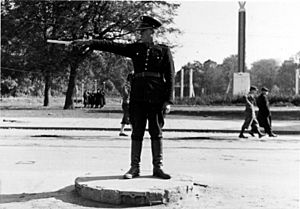
After Poland became independent again in 1919, it created a new national police force called the 'Polish State Police' (Policja Państwowa). This force was the main law enforcement agency until World War II began in 1939. Other groups, like the Border Guard, handled specific duties.
After World War II, Poland came under communist rule. The police force was renamed 'Milicja Obywatelska' (Citizen's Militia). This new name was supposed to show that the police served the people. However, in reality, the Milicja was often used by the government to control citizens. Many people did not like the Milicja because of how it acted during protests and other events.
When the communist government fell in Poland, the police system changed again. In 1990, the name 'Policja' was brought back. The new system was similar to the one before World War II.
Police Vehicles and Gear
Today, the Polish police use many different types of vehicles. Common cars include models from Kia (like the Cee'd), Škoda (like the Octavia), Ford Mondeo, Opel, Volkswagen, and Toyota. Older cars like the FSO Polonez are no longer used. Since joining the European Union, the police have bought many new vehicles to replace older ones. They also have many 4x4 vehicles and vans for different situations.
Since 2009, police cars have a new look: silver with a blue reflective stripe. This is similar to police cars in Germany. Before, they were dark blue with white doors and white stripes.
All uniformed police officers carry a firearm, handcuffs, and a personal radio. They also often have pepper spray to help control violent people without using deadly force.
Riot police, who handle large crowds or dangerous situations, wear special body armor, helmets, and shields. They might use less-lethal weapons like shotguns with rubber bullets, tear gas, or water cannons. Poland has strict rules about owning firearms, which helps keep gun crime low. This means police rarely need to use their guns.
Common Police Vehicles
The Polish Police use many different vehicles. Here are some of the most common ones:
Patrol Cars
| Image | Name | Origin | Number | Note | |
|---|---|---|---|---|---|
| Patrol cars | |||||
 |
Alfa Romeo 159 | 120 | Marked | ||
 |
BMW 320i | N/A | Marked | ||
As of 2018, the most common patrol cars are:
- Kia (Cee’d, Venga) - over 5,700 vehicles
- Opel (Astra, Vectra, Corsa, Insignia, Mokka) – nearly 2,800 vehicles
- Škoda (Octavia, Fabia, Superb, Rapid) – almost 1,000 vehicles
- Hyundai (i30, i20, Elantra) – nearly 600 vehicles
Vans
As of 2018, the police use many vans, including:
- Fiat (Ducato) – almost 1,900 vehicles
- VW (Transporter, Crafter, Multivan, Caddy) – nearly 600 vehicles
- Mercedes (Sprinter, Vito, Viano) – over 600 vehicles
- Renault (Traffic, Master, Kangoo) – over 500 vehicles
- Opel (Movano, Vivaro) – over 200 vehicles
Buses
- Autosan
- Iveco
Motorcycles
- Yamaha FJR1300
- Honda CB250
- BMW K1200S
- BMW F800ST
- Triumph Tiger 1050
- Honda CBF1000A
All-Terrain Vehicles (SUVs)
As of 2018, popular SUVs include:
- Nissan (Pathfinder, Terrano, Patrol, X-Trail, Navara) – over 200 vehicles
- Kia (Sorento, Sportage) – over 140 vehicles
- Land Rover (Defender, Freelander) – nearly 90 vehicles
- Mitsubishi (L200, Pajero) – over 120 vehicles
- Toyota (Hilux, Land Cruiser, Rav) – nearly 50 vehicles
Aircraft
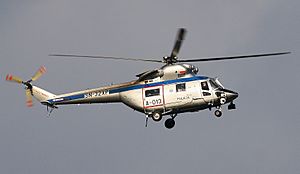
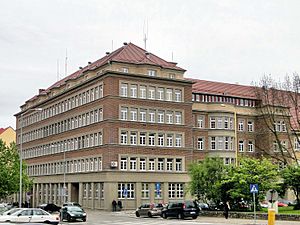
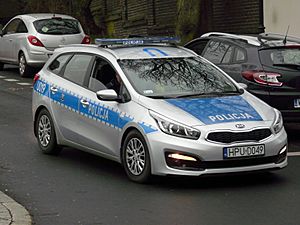


The Policja has 13 helicopters. They are based in different cities:
- Kraków - 1 x PZL W-3 Sokół
- Szczecin - 1 x PZL W-3 Sokół
- Warsaw - 2 x Mil Mi-8, 2 x Bell 407, 1 x Bell 412, 3 x Sikorsky UH-60 Black Hawk S-70i variant
- Łódź - 1 x Bell 206
- Poznań - 1 x Bell 407
- Wrocław - 1 x Bell 206
Some police units also have boats for patrolling rivers and lakes. The largest water units are on the Vistula river in Warsaw and in the Warmian-Masurian Voivodeship, which has many lakes. Near the coast, the Policja works with the Polish Border Guard to patrol the sea.
The General Commander of the Policja
The General Commander is the highest-ranking officer in the Polish police force. This position is like a general in the Polish military. The commander's main office is the National Police Headquarters in Warsaw. This office helps manage all police activities across Poland.
The role of General Commander has existed in different forms throughout Polish history. The current office started in 1990. The commanders of today's Policja are seen as successors to the leaders of the pre-World War II State Police. However, the leaders of the communist-era Milicja Obywatelska are not considered part of this line.
One former General Commander, Marek Papała, was sadly killed in 1998. His murder is still being investigated by the Polish police.
Police Ranks
The Policja has a clear system of ranks, similar to a military.
- Officers
- Other Ranks
How the Policja is Organized
The Policja is divided into different services. Each region or city has its own police command with specialized groups. This helps the police focus on different types of situations and use expert knowledge. Besides these special groups, most officers work on patrol duty and general law enforcement.
Here are some of the main groups within the Policja:
- Criminal Police (Policja Kryminalna) - They investigate and work to prevent serious crimes. This can include teams for anti-drug efforts or financial crime. They also have teams for crime scene investigation.
- Preventative Police (Policja Prewencyjna) - These officers handle general law enforcement and patrol duties. This group also includes riot police.
- Counter-terrorism Police (Policja Kontrterrorystyczna) - They handle special and high-risk operations.
- Traffic Police (Policja Ruchu Drogowego) - They focus on road safety, directing traffic, and patrolling highways.
- Logistical Support Police (Policja Wspomagająca) - This group provides support and technical help to other police units.
- Police Aviation Service (Służba Lotnictwa Policji) - They provide air support, but not every police force has this unit.
- Investigative Police (Policja Śledcza) - They investigate complex cases and prepare them for prosecutors.
- Judicial Police (Policja Sądowa) - They protect courts, judges, and prosecutors. They also protect victims and suspects, and carry out court orders.
- Maritime Police (Policja Wodna) - They patrol and pursue on water.
| Branch | Criminal | Preventative | Traffic | Logistical Support | Special and Riot Branch | Judicial |
| Insignia |  |
 |
 |
 |
 |
 |
Anti-Terrorism Units
The Policja has highly trained anti-terrorism units. The main national unit is called BOA KGP (Central Counter-terrorism Police Subunit). In each region, there are smaller units called SPAP (Samodzielny Pododdział Kontrterrorystyczny Policji), which means Independent Counter-terrorism Policja Subunit. These units handle dangerous arrests, search warrants, and hostage rescues.
These special units often train with similar police forces from other countries like the Czech Republic, Slovakia, and Germany. They also train with other Polish special forces.
-
A Mercedes-Benz Sprinter of the Policja in Kraków
International Work and Cooperation
Since 1990, the Policja has taken part in many international peacekeeping and police missions around the world. They have sent officers to missions in places like Liberia, Bosnia and Herzegovina, Afghanistan, Georgia, and Kosovo.
The Policja also works with international law enforcement groups like Europol and Interpol. Polish officers are a significant part of Europol's staff. This cooperation has grown even more since Poland joined the Schengen Agreement in 2007. This agreement allows for easier travel and police cooperation across borders in Europe. Because of this, Polish police work closely with police in Germany, the Czech Republic, Slovakia, and Lithuania.
As a member of Interpol, the Polish police follow international arrest warrants and work with other countries' police forces through official channels. This cooperation has helped catch many dangerous criminals.
Police Organization in Poland
The Polish Police is a centralized force. This means it is organized under one main command in Warsaw. All officers are assigned to one of 17 regional or city commands. Some specialists work directly for the national commander.
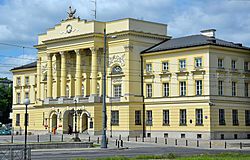

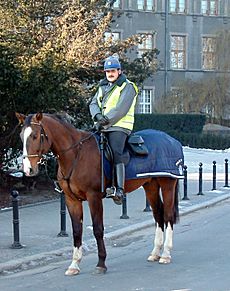
Regional Police Headquarters
| Territorial Force | Seat | |
|---|---|---|
| Voivodeship (or its part) | Unit | |
| Image:POL Lublin COA 1.svg Lublin | ||
| Capital Metropolitan Police Headquarters | ||
| Image:POL Opole COA.svg Opole | ||
Police Training Schools
The Policja has five training schools in Poland. Four of them are for new police recruits. The fifth is a higher education school for officers and senior officials. The four schools for recruits are in:
- Piła, Greater Poland Voivodeship
- Słupsk, Pomeranian Voivodeship
- Katowice, Silesian Voivodeship
- Legionowo, Masovian Voivodeship
The main police training school is the Wyższa Szkoła Policji (Higher Police School) in Szczytno. This school trains officers and teaches them about criminal law, constitutional law, and economic law. They also learn modern policing skills, how to use weapons, and computer skills. This school works with other police academies around the world.
Special Police Units
The Policja Honor Guard
The Representative Honor Guard Company (Polish: Kompania reprezentacyjna Policja) is the special ceremonial unit of the police. They perform public duties and drills for the police force and the President of Poland. They often participate in national events, like the annual National Independence Day ceremony in November.
The Policja Band
The Policja's official band started in 1968. Over time, it grew and became very skilled. The band has won many awards. They perform at national, religious, and state events. They have also played concerts in other countries like Denmark, Belgium, and Russia. The band plays many types of music, including marches and concert pieces. They often play for important national holidays, like 3rd May Constitution Day.
Public Trust in the Policja
People's trust in the Policja has grown a lot since 2001. In 2001, only 46% of people thought the police were doing a good job. By 2009, this number had risen to about 72%. This level of trust is similar to what is seen in other European Union countries.
Sometimes, the Policja receives criticism for how it handles law and order, especially from young people. This is often shown with acronyms like (C)HWDP and JP.
Images for kids
-
Two policemen (old patrol uniform) patrol Kraków's Old Market Square
-
BMW 3 Series squad car of the Policja
See also
 In Spanish: Policja para niños
In Spanish: Policja para niños
- Milicja Obywatelska (MO) - the police service during the communist era
- Ministry of Internal Affairs and Administration of the Republic of Poland (Ministerstwo Spraw Wewnętrznych i Administracji)
- Służba Bezpieczeństwa (SB) - the secret police service during the communist era


